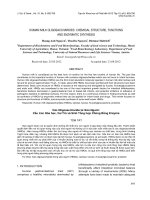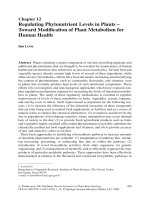Human origins 101
Bạn đang xem bản rút gọn của tài liệu. Xem và tải ngay bản đầy đủ của tài liệu tại đây (2.53 MB, 218 trang )
P1: 000
GGBD138FM
GR3673/Dunsworth
Human Origins 101
July 12, 2007
16:32
P1: 000
GGBD138FM
GR3673/Dunsworth
Recent Titles in the
Science 101 Series
Evolution 101
Janice Moore and Randy Moore
Biotechnology 101
Brian Robert Shmaefsky
Cosmology 101
Kristine M. Larsen
Genetics 101
Michael Windelspecht
July 12, 2007
16:32
P1: 000
GGBD138FM
GR3673/Dunsworth
July 12, 2007
Human Origins 101
Holly M. Dunsworth
Science 101
GREENWOOD PRESS
Westport, Connecticut r London
16:32
P1: 000
GGBD138FM
GR3673/Dunsworth
Library of Congress Cataloging-in-Publication Data
Dunsworth, Holly M.
Human origins 101 / Holly M. Dunsworth.
p. cm. — (Science 101, ISSN 1931-3950)
Includes bibliographical references and index.
ISBN 978–0–313–33673–7 (alk. paper)
1. Human beings—Origin. 2. Human evolution. I. Title.
GN281.D865 2007
599.93 8—dc22
2007022747
British Library Cataloguing in Publication Data is available.
Copyright c 2007 by Holly M. Dunsworth
All rights reserved. No portion of this book may be
reproduced, by any process or technique, without the
express written consent of the publisher.
Library of Congress Catalog Card Number: 2007022747
ISBN-13: 978–0–313–33673–7
ISSN: 1931-3950
First published in 2007
Greenwood Press, 88 Post Road West, Westport, CT 06881
An imprint of Greenwood Publishing Group, Inc.
www.greenwood.com
Printed in the United States of America
The paper used in this book complies with the
Permanent Paper Standard issued by the National
Information Standards Organization (Z39.48–1984).
10 9 8 7 6 5 4 3 2 1
July 12, 2007
16:32
P1: 000
GGBD138FM
GR3673/Dunsworth
July 12, 2007
For Mom and Dad,
Model Human Beings
16:32
P1: 000
GGBD138FM
GR3673/Dunsworth
July 12, 2007
16:32
P1: 000
GGBD138FM
GR3673/Dunsworth
July 12, 2007
Contents
Series Foreword
Preface
Acknowledgments
Introduction
xi
xiii
xvii
xix
1.
A Brief Overview of the Search for Human Origins
The Science of Human Origins and Evolution
Scientific Method
Forefathers
Piltdown
Dubois and Beyond
Current Issues
1
1
2
5
9
10
13
2.
From Fish to Fishermen
Evidence for Evolution
Biogeography
Fossils and Geology
Artificial Selection
Homology and Analogy
Vestigial Traits
Embryology
Natural Selection
Variation
Heredity
Differential Fitness
Adaptation
From Mendel to the Modern Synthesis
DNA, Chromosomes, Cells, and Inheritance
17
17
18
19
19
19
21
21
22
23
23
24
24
25
27
16:32
P1: 000
GGBD138FM
viii
GR3673/Dunsworth
July 12, 2007
Contents
Forces of Evolution
Mutation
Gene Flow
Genetic Drift
Selection
Sexual Selection
Speciation
Clarifying Evolution
Taxonomy and Classification
Primates
Monkeys and Apes
30
30
31
31
31
32
34
37
38
41
44
3.
Prehistoric Evidence
What Is a Fossil?
Geology and Dating Methods
Climate Change and Paleoenvironment
The Earliest Primates and Fossil Monkeys
Fossil Apes
Bushes and Trees
The Last Common Ancestor
Quadrupedal to Bipedal
The Earliest Hominins
Sahelanthropus
Orrorin
Ardipithecus
Australopiths
Australopithecus anamensis
Australopithecus afarensis
Australopithecus africanus
Australopithecus garhi
Paranthropus (Robust Australopiths)
The Human Genus
Homo erectus
Archaic Homo Sapiens
Neanderthals
Stone Tools
Anatomically Modern Humans
Homo Floresiensis
47
47
50
54
55
57
61
62
64
65
67
69
69
70
72
73
75
77
78
80
82
86
88
90
93
95
4.
Modern Evidence
Molecular Clocks
Humans and Chimpanzees: The Narrow Divide
97
97
99
16:32
P1: 000
GGBD138FM
GR3673/Dunsworth
July 12, 2007
Contents
Mitochondrial Eve and Y-Chromosome
Adam
Human Adaptation
Sickle Cell Trait
Lactose Tolerance
Skin Color
Ancient DNA and the Neanderthal
Genome
102
105
106
106
107
109
5.
Interpreting the Evidence
Big Brains and Intelligence
Evolutionary Psychology
Bipedalism
Reduced Body Hair
Body Size, Shape, and Strength
Teeth
Tool Use
Diet
Scavenging and Hunting
Fire
Reproduction
Language
Human Revolution
Altruism and the Human Colony
War or Peace?
113
113
117
118
122
124
126
128
131
133
136
137
140
143
146
148
6.
Beyond Human Origins
Multiregional and Out of Africa Models
Worldwide Dispersal
Will We Evolve or Will We Go Extinct?
Deep Impact
Rewinding and Replaying Evolution
151
151
155
158
160
162
Appendix A: Human and Chimpanzee Skeletal Anatomy
Appendix B: Geologic Time Scale
Appendix C: Recommended Resources
Glossary
Selected Bibliography
Index
165
167
169
171
179
185
16:32
ix
P1: 000
GGBD138FM
GR3673/Dunsworth
July 12, 2007
16:32
P1: 000
GGBD138FM
GR3673/Dunsworth
July 12, 2007
Series Foreword
What should you know about science? Because science is so central
to life in the 21st century, science educators believe that it is essential
that everyone understand the basic foundations of the most vital and
far-reaching scientific disciplines. Human Origins 101 helps you reach
that goal—this series provides readers of all abilities with an accessible
summary of the ideas, people, and impacts of major fields of scientific
research. The volumes in the series provide readers—whether students
new to the science or just interested members of the lay public—with
the essentials of a science using a minimum of jargon and mathematics.
In each volume, more complicated ideas build upon simpler ones, and
concepts are discussed in short, concise segments that make them more
easily understood. In addition, each volume provides an easy-to-use glossary and an annotated bibliography of the most useful and accessible
print and electronic resources that are currently available.
16:32
P1: 000
GGBD138FM
GR3673/Dunsworth
July 12, 2007
16:32
P1: 000
GGBD138FM
GR3673/Dunsworth
July 12, 2007
Preface
The short answer to the question of human origins has already been
triangulated by genetics, paleontology, and archaeology: 200,000 years
ago in sub-Saharan Africa.
So why do we need an entire book just to introduce the subject?
Because the long answer is an ever-lengthening saga that contains as
many chapters as there are traits that make up the human species.
Different aspects of Homo sapiens arose at different times to build the
creatures we are today. The three tiny bones in our ears for hearing
evolved over 100 million years ago, but we did not begin to make musical
instruments until at least 100,000 years ago. Each acquisition of a human
trait affected events further along the human evolutionary path. It is
because of this broader quest for human origins that there is more to
discuss than simply “200,000 years ago in sub-Saharan Africa.”
If every human drew their family tree all the way back to the beginning
of life on planet Earth, each person’s history would be identical from the
Big Bang until very recently, when our individual histories—the twigs
on our tribal lineages—diverged from the branches of other human
groups and became geographically and genetically distinct. Just like a
person can trace her curly hair back through generations by looking at
photographs of her cousins, grandparents, and great-grandparents, the
human species can trace its roots back by looking at fossils and genes that
reveal our shared ancestries with our extinct hominin ancestors and with
our “cousins”—apes, monkeys, mice, horses, fishes, worms, corn, slime
molds, bacteria, and every living thing that humans have ever bothered
to name.
It is because of our intellect that we often very easily forget that we
are members of the animal kingdom, working under and shaped by
the same basic evolutionary processes as all other living things. Despite
16:32
P1: 000
GGBD138FM
xiv
GR3673/Dunsworth
July 12, 2007
Preface
the long list of differences that we imagine separate or elevate us from
other animals, we differ from chimpanzees by less than 2 percent of our
genetic code (which is not much considering it is 3 billion base-pairs
long). Certainly it is our differences from other animals that define us
as humans, but it is our fundamental similarities to those animals that
eventually allowed us to become humans.
Knowing we are upright, chattering African apes need not send us
into an existential crisis, not with the knowledge that each one of us is
unique. No two people have exactly the same DNA, not even adult twins.
No one in the past or future will ever have the same genetic code as any
other person in the past or future, or any other organism for that matter.
Each one of us is the result of a single successful, uninterrupted chain of
life that began 3 billion years ago. Instead of using this strangely sharp
intelligence to wallow in our ordinary primateness, we should, instead,
marvel at what natural selection and other biological forces produced
from an ancestor with monkey-like brains.
As arguably the only self-conscious creatures on the planet, it is shocking how little we know about ourselves. Many people, if asked, will tell
you they are a “Homo sapien,” incorrectly assuming the species in our
scientific name is plural. Some people could assemble the parts of a
sports car down to the last ball bearing, but could not locate their own
semi-circular canals, let alone describe what they do. (They are in the
ears but they have nothing to do with hearing. They are involved in
seeing clearly while the head is moving around.)
Through oral and written histories we immortalize our family genealogies, we even name our babies after their ancestors, but we can rarely
be bothered to remember the very long, strangely pronounced names
of our extinct evolutionary ancestors. Next to the anatomy books on
our library shelves are volumes instructing us in the basic aspects of life,
things other animals do instinctually or learn from one another without
spoken or written language, like reproducing, raising offspring, making
friends, running efficiently, hunting effectively, eating the right foods,
and surviving in “the wild” without a mobile phone.
In the following pages, the overwhelming evidence for human origins and evolution and the fundamental concepts used to interpret
that evidence are introduced and discussed as only humans can do,
with an arbitrary system of symbols printed on processed tree pulp.
Reading about the first spear throwers, prehistoric mammoth-hunting
injuries, or the first sea-faring journey to Australia should be like reading about the miraculous throwing arm on your great-uncle, about how
your great-grandfather died reeling in a 150-lb fish, or about how your
16:32
P1: 000
GGBD138FM
GR3673/Dunsworth
July 12, 2007
Preface
great-great-great grandmother emigrated to America on a boat from
Ireland.
It is my hope that readers of Human Origins 101 take away this important tenet of human origins studies: we are modified African apes that,
despite seemingly great variation in biological and cultural ornamentation, share a common African ancestor. We are all one diverse species
with regionally varying physical characteristics that are the results of environmental adaptations, mate preferences, migration, or simply chance.
Culture has a significant effect on the differences we perceive in other
people. Underneath the t-shirts, face paint, piercings, tattoos, mohawks,
and stilettos, we are all remarkably similar. It is because of our unique
makeup that we have both the propensity to forget and the ability to
embrace that we are an integral part of the natural world around us.
16:32
xv
P1: 000
GGBD138FM
GR3673/Dunsworth
July 12, 2007
16:32
P1: 000
GGBD138FM
GR3673/Dunsworth
July 12, 2007
Acknowledgments
For inspiration, discussion, and guidance, I am happily indebted
to Kevin Stacey, Julie Dunsworth, Cheryl Hill, Pat Shipman, David
Carlson, Brian Regal, members of the Penn State biological anthropology journal club, and the students from my spring 2006 course in
biological anthropology. Alan Walker and Jeffrey Kurland kindly allowed
me to bask in the glow of their very clever brains for the last seven years.
Enormous gratitude goes to Greenwood editor Kevin Downing. Drawings and maps were artistically prepared by Jeff Dixon. Thanks to Kristina
Aldridge, Mark Teaford, David Lordkipanidze, Chris Campisano, Alice
Teeple, and students of the 1998 Rutgers Koobi Fora field school for assisting with photographs and figures. Any errors on the following pages
are mine alone. Few of the ideas presented in these pages are new ones
and I thank all of the people responsible for them. Thanks most of all to
the people who work in hot deserts, cold caves, lonely museum stacks,
and sterile laboratories for their tireless curiosity and enthusiasm for
human origins and evolution.
16:32
P1: 000
GGBD138FM
GR3673/Dunsworth
July 12, 2007
16:32
P1: 000
GGBD138FM
GR3673/Dunsworth
July 12, 2007
Introduction
Piecing together the puzzle of human origins and evolution is an
interdisciplinary endeavor. The fields of genetics, paleontology,
paleoanthropology, archaeology, cultural anthropology, primatology,
animal behavior and ecology, anatomy, physiology, kinesiology, psychology, cognitive sciences, economics, and many others offer pieces of the
puzzle.
The roots of humankind can be traced back to the beginnings of
the universe because we are composed of atoms, to the dawn of life on
earth because we are carbon-based, to the first fish to make a living on
land because we are tetrapods, to the small mammals that survived the
dinosaur-ending apocalypse because we suckle milk as babies and are
furry (some more than others), to the apes that for some strange reason
got good at teetering around on their hind legs, and finally to expert
bipeds with big brains for mastering tool-making and language.
Certainly the entire history of the universe as it pertains to human
origins and evolution cannot be covered in this volume. The main focus
of human evolutionary studies (and the main focus here) is the roughly
6 million crucial years from the moment our lineage split from the
ancestors we share with chimpanzees up until the first modern humans
emerged in Africa, just before our individual and population histories
began to diverge.
Although most technical terms are defined in the glossary, there are
two that need special attention from the start. Hominins are modified
African apes. They include living humans and all the extinct descendents of the last common ancestor with chimpanzees that are on the
human lineage as opposed to the chimpanzee lineage. Fossil hominins
are either our direct ancestors or are our evolutionary cousins located
on different branches of the hominin tree from ours. Most hominins
16:32
P1: 000
GGBD138FM
xx
GR3673/Dunsworth
July 12, 2007
Introduction
are bipedal and relatively large-brained, but the very earliest ones may
not have been so, if those traits did not evolve immediately after the split
from the common ancestor with chimpanzees. Humans are the only surviving hominin species and are distinct from other hominin species in
our unique combination of complex material culture, social behavior,
bodily characteristics, and intelligence. In this book, we will refer only to
anatomically modern humans or Homo sapiens as “humans.” These are
people we would call “people” if we were to stand eye-to-eye with one
of them. To put it another way, if we traveled back in a time machine
to 200,000 years ago we would probably recognize the upright walking
beings as human beings (even though they probably did not yet use
language or symbolism like we do), but there is no guarantee that we
would connect the same way with anything living before that, not necessarily even with Neanderthals who lived side by side with some human
populations until 30,000 years ago. Although some scientists refer to
everything within the human genus (Homo) as “humans,” we will reserve
that title for ourselves only.
It seems logical that if one is to study human origins there should
be universal agreement as to what exactly makes a human “human.”
But if asked, “what defines humans or what makes them unique?” many
popular answers lie within the intellectual and emotional realm: love,
laughing, regret and loss, creativity, curiosity, hunger for learning, perception of things unseen, concept of the future, spirituality, suicide, and
language. These are not the types of traits that are readily traced through
prehistory with fossils, artifacts, or genetics. Comparative observations of
other animals help us understand the nature of these human attributes,
but the more we learn, from apes in particular, the more we find that
very little of what defines humans is exclusively human.
The 2 percent of our genome that differs from chimpanzees sometimes seems too small to contain all of our differences. Physically, we have
a larger brain with thick hair covering the skull and, in males, the face as
well. Our body hair is drastically reduced and our naked skin contains
many more sweat glands. Our hands are much more dexterous but our
bodies are much weaker than chimpanzees’. We have large conspicuous
sex organs and we walk on only two very long legs shod with rigid, sturdy
feet. Much of the white of our eyes, which is whiter than other apes,
is visible due to the almond shape of our eyelids. Behaviorally, we depend on highly complex vocalizations. We control fire. We graffiti nearly
everything, including ourselves. On the whole, we peacefully gather in
enormous groups containing mostly unrelated individuals. We exploit
and selectively breed other species (and even members of our own, in
16:32
P1: 000
GGBD138FM
GR3673/Dunsworth
July 12, 2007
Introduction
arranged marriages). We are skillful hunters without fangs and claws
and are capable of adapting to every sort of environment on earth.
In the following pages we track the origin and evolution of the traits
that enabled humans to become “human.” If these traits will someday
be mapped in the genome, we will find that they are expressed or
regulated by that less than 2 percent DNA difference that separates us
from chimpanzees. As we learn more about our own genome and that
of related animals, we are finding that most of what we consider unique
to our species probably emerged recently and because most traits are
complex and expressed through multiple genes, uniquely human traits
are going to be a challenge to pinpoint at the molecular level, let alone
trace through evolution.
By no means can the entire field of human origins fit into a single
book, so the fundamentals and the highlights of the material evidence
are included here. For anatomical vocabulary as well as the epochs, periods, and eras of geologic time, please consult Appendices A and B.
Throughout the text “Mya” and “Kya” will be shorthand for millions
of years ago and thousands of years ago. For additional, in-depth information, check the recommended resources in Appendix C, and the
references in the bibliography for places to start your own quest for
human origins.
Chapter 1 begins the book with a brief history of the search for human origins and human evolutionary studies. As a consequence of selfconsciousness, humans have probably been curious about their origins
since the first hominin developed the mental capacity to do so. But the
modern study of human origins did not seriously begin until the middle
of the 19th century when the first Neanderthals were found in Europe.
Early in the history of the field, the controversy surrounding new discoveries was due to uncertainty as to whether or not humans evolved at all.
Now that the old controversy has been conquered by science, controversy surrounding new discoveries merely refers to the details involved
in their interpretation. Unless fossils come with identification tags, there
will always be controversy about how to interpret them. For most every
issue, however, there is a majority of scientists who agree on an interpretation which becomes the working paradigm unless a new discovery
flips everything upside down again. This collegial debate over new finds
is still, unfortunately, repackaged and then touted by antievolutionists
as proof that there are flaws in evolutionary theory.
Because this book is centered on the processes of evolution, Chapter 2
outlines evolutionary theory and walks through Darwin’s formulation of
the theory of evolution by natural selection and also by sexual selection.
xxi
16:32
P1: 000
GGBD138FM
xxii
GR3673/Dunsworth
July 12, 2007
Introduction
It focuses on how we understand evolution today with our current grasp
of genetics. In this chapter we look to the evidence we glean from the
living world around us for human origins and evolution, so methods of
classification and forming family trees are discussed and then groups
within the Order Primates, of which we are a member, are discussed.
Without time travel, one can never be truly certain what life was like
before moving pictures were first recorded or before people began to
write down history. Old bones and stones, however, provide an astonishing amount of information about the origins and evolution of humans.
In Chapter 3, we dig down to bare bones of our search for evidence of
human origins, into the fossil and archaeological records. We meet our
ancestors and our close cousins, and we sort through the garbage they
left behind. We discuss the fossils and artifacts that by chance got preserved, that by hard work and a little luck got discovered, and that by
careful scientific scrutiny got interpreted as evidence for the nature of
our origin and evolution. Our body’s architecture and mechanics are
only part of the vastly underappreciated knowledge researchers are compiling everyday on our evolution and place in nature. The establishment
of geologic methods in the beginning of the chapter puts the fossils into
perspective. Early fossil primates, monkeys, and apes are briefly toured
and then once hominins are reached they are organized into subheadings by species. Only the general anatomical features are discussed, but
keep in mind that scientists base species distinctions and anatomical
interpretations on careful measurements and statistical analyses.
Because so much of evolutionary theory relies on modern genetics,
Chapter 4 includes advances that the field of genetics has made in our
understanding of human origins and evolution. Through DNA, human
ancestry can be traced as far back as the origins of life and multicellular organisms. With increasingly powerful biotechnology, the search for
human origins is no longer simply based on dusty fossils and artifacts.
Today, artifacts within the genome are just as important as those buried
in the ground. In an age where molecular analysis is ever increasing
in precision and scope, we can use it as a tool for tracking our evolution. Knowledge of genes and inheritance from Chapter 2 is used to
explore the use of molecular clocks to determine lineage-splitting times
in prehistory, the role of mitochondrial DNA in determining our African
ancestry, and also the evolution of some recent human adaptations. Although ancient DNA is not technically modern evidence, the techniques
by which it is extracted and analyzed are modern, so it is included here.
In Chapter 5 we synthesize the evidence from living animal models,
fossils, artifacts, and genetics in order to track the origins and evolution
16:32
P1: 000
GGBD138FM
GR3673/Dunsworth
July 12, 2007
Introduction
of some fundamental human traits. Consider this chapter a blueprint
for building a human from an ape-like ancestor as opposed to building
a chimpanzee from that same ancestor. The evolution of many, if not
all, human traits are highly dependent on the evolution of others. For
example, the adoption of habitual bipedalism allowed selection to act
on the anatomy of newly freed hands that became even more adept at
using and making increasingly elaborate tools. Therefore, one cannot
adequately study bipedalism without understanding the archaeological
record of stone tools.
Our ancestors were shaped by the same natural processes and evolutionary forces as all other earthly organisms. But despite worldwide
dispersal, cultural complexity, the innovative modifications we make to
our surroundings, and the great impact we have on the environment,
are those same forces working on humans today? What spurred modern
humans to spread across the world in the first place and how and when
did world colonization occur? Will we have time to evolve much more
or will we go extinct before we can find out? And if given the chance
to do it all over again, would humans still evolve? These questions are
asked in Chapter 6.
Evolutionary research is revolutionary. With additional discoveries
from dig sites and from the use of new technologies, not only can hypotheses about human origins and evolution be tested and retested from
many different scientific perspectives, but they are constantly tweaked
to reflect the influx of new evidence. Tomorrow someone could find a
new piece of the puzzle that either reinforces what most people already
knew or that totally overturns their perspectives and forces them to rethink the whole thing. A new fossil species or a genetic breakthrough
can change the way we think about our origins and evolution literally
overnight.
If, hypothetically, someone tomorrow discovers a fossil hominin from
9 Mya that walked upright, then parts of this book will need to be
rewritten (because as it stands now, the overwhelming evidence points
to a hominin origin at about 6 Mya). But no matter the future of the
science of human origins and evolution, the information contained
in this volume serves as a basis for understanding why such a discovery
would be significant and how it would impact the current understanding
based on the overwhelming evidence from the fossil, archaeological, and
genetic records.
xxiii
16:32
P1: 000
GGBD138FM
GR3673/Dunsworth
July 12, 2007
16:32
P1: 000
GGBD138C01
GR3673/Dunsworth
July 12, 2007
1
A Brief Overview
of the Search for
Human Origins
THE SCIENCE OF HUMAN ORIGINS AND EVOLUTION
Whether they study Ice Age cave paintings, chimpanzee DNA, or the
bones of the first tiny squirrel-like primates from 60 million years ago,
scientists are asking the same questions: Where did we come from and
how did we get here?
Although the search for human origins draws upon research from
many scientific disciplines, it is mainly kept to the field of anthropology. Broadly defined as “the study of humans,” anthropology can encompass any scientific pursuit as long as it has a human
focus.
Biological anthropology (also called physical anthropology) is a field
within anthropology, and all of its subfields contribute directly or indirectly to the understanding of human origins and evolution. These
subfields include scientific investigations of the genetics, behavior, biology, ecology, and evolution of humans and nonhuman primates that fall
under disciplines like “paleoanthropology,” which is the study of human
evolution (Figure 1.1), and “primatology,” which is the study of living
primate behavior and ecology.
Biological anthropology does not stand alone in the search for human
origins. The other anthropological fields of archaeology and cultural
anthropology are also crucial to the understanding of human origins
and evolution.
Because paleoanthropology reconstructs the ancient past, it is a historical science. Thus, it is difficult to make the same types of conclusions
that chemists or cell biologists can make from eye-witnessing experiments. In paleoanthropology, “Mother Nature” has performed the experiments and thousands or millions of years later, scientists describe
14:31









